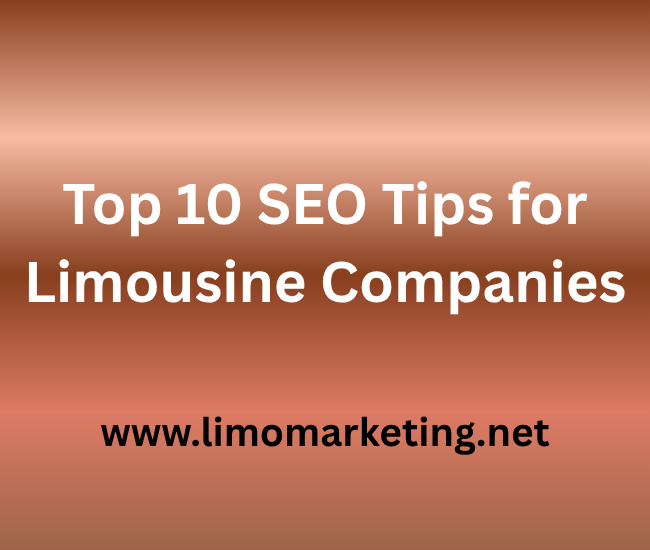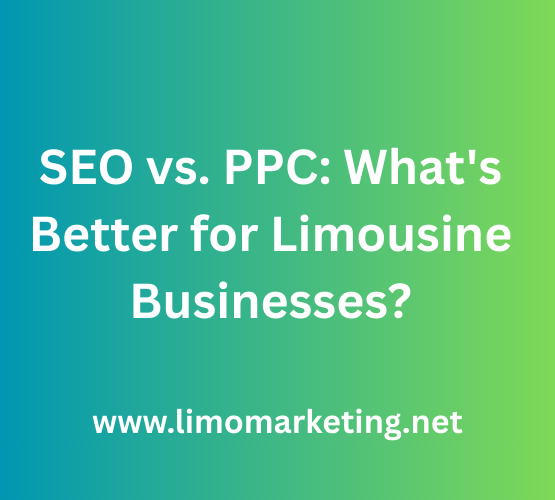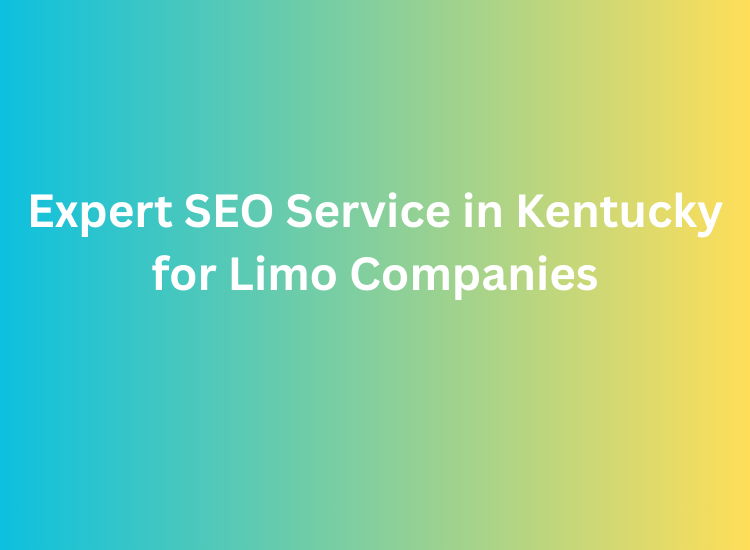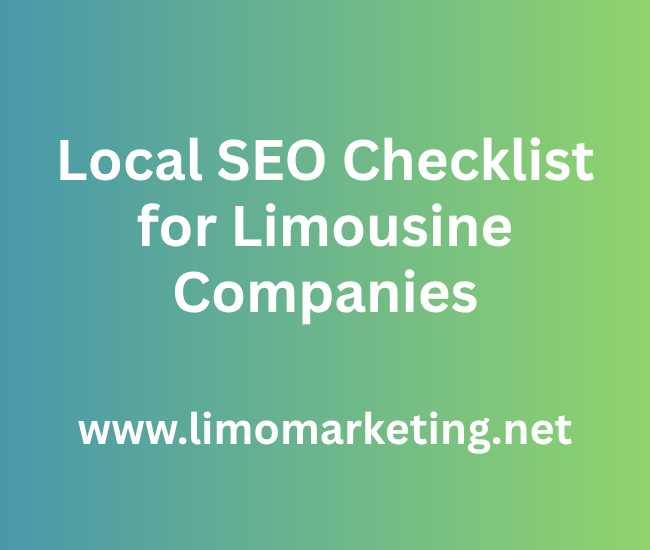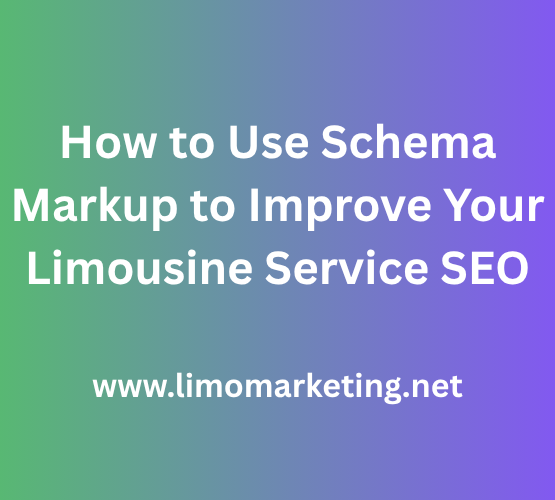Top 10 SEO Tips for Limousine Companies
At Limo Marketing, we specialize in helping limousine businesses grow through expert SEO strategies. In this guide, we’re sharing 10 practical SEO tips that can drive more traffic to your website and increase your booking rate. If you run a limo company, these methods can help you stand out in your local market.
This article shares ten practical SEO tips drawn from our experience working with limo companies across the country. Whether you run a fleet of executive cars or a single stretch limousine, these steps will help you increase your search rankings, attract more local traffic, and convert searchers into riders.
1. Start with a Local SEO Audit
Before making any changes, conduct a local SEO audit to identify what’s working and what’s holding your site back. We review your Google Business Profile, check for NAP (Name, Address, Phone) consistency across directories, and evaluate your local keyword rankings. Tools like BrightLocal, Whitespark, or Semrush’s Local SEO Toolkit can help analyze your citations, reviews, and location-based visibility.
An audit lays the groundwork by exposing technical gaps, missing listings, or duplicate content. For limousine businesses, we often uncover conflicting directory listings or weak city-specific landing pages—both of which can be resolved for quick SEO gains.
2. Optimize Your Google Business Profile
Google Business Profile (GBP) is often the first impression clients get. Make sure your profile is complete with categories like “Limousine Service,” “Airport Shuttle,” or “Chauffeur Service.” Add high-quality photos of your fleet, office, and drivers, and update your business hours accurately.

Regularly post updates using the “Posts” feature—highlighting seasonal offers, fleet upgrades, or service areas. Encourage satisfied clients to leave reviews and respond professionally to every review, positive or negative. A fully optimized GBP improves visibility on Google Maps and the local pack, placing your company ahead of competitors during key searches.
3. Target City and Service-Specific Keywords
Generic keywords like “limo rental” are too broad. We help limo companies focus on geo-specific and service-focused terms such as “wedding limo Los Angeles” or “Houston airport car service.”
Use tools like Google Keyword Planner or Ahrefs to find search volume and competition. Then, integrate these keywords naturally into page titles, H1 headers, service pages, and image alt text. Each primary city or service should have its own page—this increases relevance and helps search engines understand your niche and coverage area.
4. Create Dedicated Pages for Each Location
If you serve multiple cities or counties, don’t rely on one generic “service area” page. Create separate landing pages for each location you serve: for example, “Limo Service in San Diego,” “Limo Service in Irvine,” and so on.
Each page should include city-specific content, such as local testimonials, service descriptions, and embedded Google Maps. We’ve seen limo companies rank significantly higher by simply building out properly optimized local pages that mirror how people search in real life.
5. Use Schema Markup for Local Business
Structured data or schema markup helps search engines better understand your business. For limousine companies, using LocalBusiness schema can display additional info in search results, like star ratings, reviews, and business hours.
Add structured data for your address, phone number, services, and service areas using tools like Google’s Structured Data Markup Helper or Schema.org. For multi-location operators, apply schema on each city page individually. It increases your chances of appearing in rich snippets, which can significantly improve your click-through rate.
6. Publish Service-Oriented Blog Content
Consistent blogging isn’t just for news sites. Limo companies can benefit from publishing content that answers real client questions. Write about topics like “Top 5 Benefits of Hiring a Wedding Limo,” “What to Expect from Airport Chauffeur Services,” or “How to Book a Prom Limo in Miami.”
We use keyword-driven blog strategies to help our clients rank for long-tail searches. Include internal links to service pages, city pages, and your contact form. Add high-quality images of your vehicles or events, and use H2/H3 structure to organize information clearly.
7. Build Local and Industry-Relevant Backlinks
Backlinks from reputable sources improve authority and rankings. For limousine businesses, target local directories, wedding vendor listings, event planning blogs, and transportation industry associations.
We recommend submitting to platforms like WeddingWire, The Knot, Chamber of Commerce, and local tourism boards. You can also reach out for guest post opportunities or partner with local hotels, event venues, or travel agencies for reciprocal linking. Focus on quality over quantity—10 relevant links outweigh 100 low-quality ones.
8. Ensure Your Site Is Mobile-Friendly
Most limo clients search on mobile—especially when they need quick transport. A site that loads slowly, has small text, or broken forms will lead to lost bookings. Use Google’s Mobile-Friendly Test to assess your site.
Your website should load in under three seconds, display clearly across screen sizes, and offer tap-friendly navigation. Features like click-to-call buttons and streamlined quote forms can make it easier for users to take action. We always prioritize responsive design when working on limo websites.
9. Improve Your Website’s Technical SEO
Behind-the-scenes elements like site speed, secure HTTPS protocol, proper redirects, clean URLs, and internal linking all contribute to search performance. Use tools like Screaming Frog, PageSpeed Insights, or Ahrefs Site Audit to identify crawl errors and broken links.
We commonly see limo sites with outdated themes, oversized images, or slow plugins—issues that harm rankings and user experience. Fixing these technical problems improves crawlability and helps your site rank higher without changing the content.
10. Track and Measure SEO Performance Regularly
SEO is not a one-time fix. Regular tracking helps measure results and guide improvements. Use Google Analytics, Google Search Console, and tools like Semrush or Moz to monitor traffic, keyword positions, page performance, and backlink profiles.
Set up goal tracking for key actions like form submissions or quote requests. Review your local rankings monthly to ensure your listings and pages remain competitive. At Limo Marketing, we build customized reporting dashboards for each limo company we work with—so nothing slips through the cracks.
Conclusion
Effective SEO for limousine companies requires a mix of technical setup, local targeting, content development, and ongoing analysis. Whether you’re focused on airport transfers, wedding packages, or executive rides, the strategies above will help you gain more visibility and attract consistent bookings.
If you’re unsure where to begin or want expert help implementing these strategies, we’re here for you.
At Limo Marketing, we specialize in search engine strategies for transportation businesses. Let’s discuss how we can help your limo company rank higher, attract more clients, and grow sustainably through SEO.
→ Contact Limo Marketing today for a free SEO consultation tailored to limousine services.
